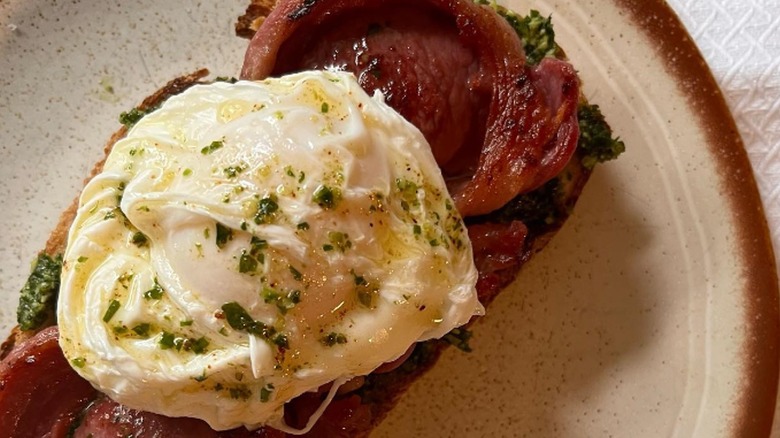The Bacon Substitute That Gives Your Breakfast A Savory Twist
If next time you are scrolling through your TikTok and encounter yourself with a recipe with macon, it's not a misspelling of bacon. Macon is bacon made from curated mutton, the meat from an adult sheep. To produce this bacon, the sheep are slaughtered at three years old. Usually, its flavor is described as gamier, stronger than lamb, the one-year-old or younger sheep. You can also call it mutton bacon, but macon would definitely be faster to pronounce.
Mutton is widely prepared in England — braised mutton shoulder is an iconic dish — and macon has been widely used in the country for centuries. Today, it is rarely found in large grocery store chains as it is a farm-made product. Historically, the term "macon" was coined in the Second World War when there was a surplus of sheep led to an increase in the meat's popularity (via Foods of England). It is still a way of making the most out of the animal.
As it is not easy to buy it in supermarkets worldwide, some suggest preparing a homemade version of the macon. The procedure is basically braising mutton belly until a certain point when slicing it finely is easy. Then, the secret relies on the marinade to get the best smokiness possible. If you are lucky to find it in a store or farm, the easiest way to explore it would be to ask yourself where you normally use bacon and switch to macon instead.
How to prepare macon
Macon can be used in the exact same way as bacon, as it also provides a nice amount of grease and saltiness. It is great for people that would prefer to skip pork for religion, dietary choices, or personal preferences.
Just like bacon, you can fry it, air-fry it for a healthier take, or grill it with some type of maple syrup or your spices of preference. If you want to make several strips at a time, you could also pop them into the oven to bake. No matter the method, try browning it until crispy, but chewy in the middle. Then the fun begins: Try it on your next eggs benedict, in a breakfast BLT sandwich, or as a side of any pancake or omelet. There are no exact rules. You can also use the macon to cook, like for a pasta carbonara; or use the macon fat to fry your burgers.
Of course, if you really want to be authentic to the dish's origins, you could try making a traditional English breakfast with macon. Fry up some macon on the stove and serve the meat alongside two fried eggs, toast, and baked beans. You could also throw in some tomatoes and mushrooms to really make it authentic.

